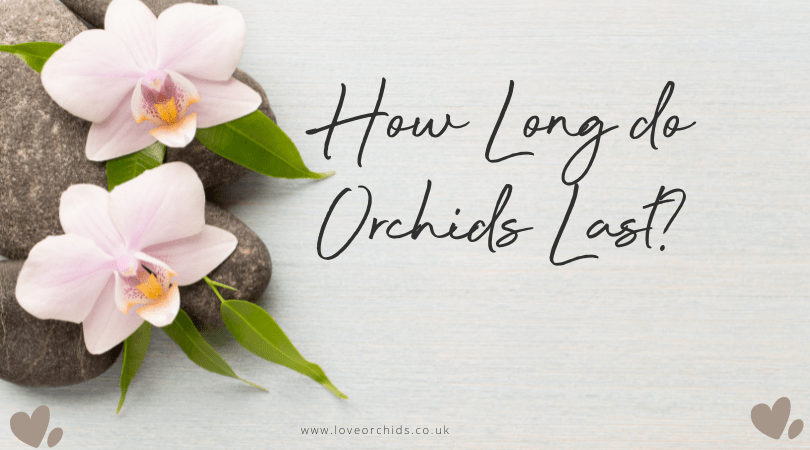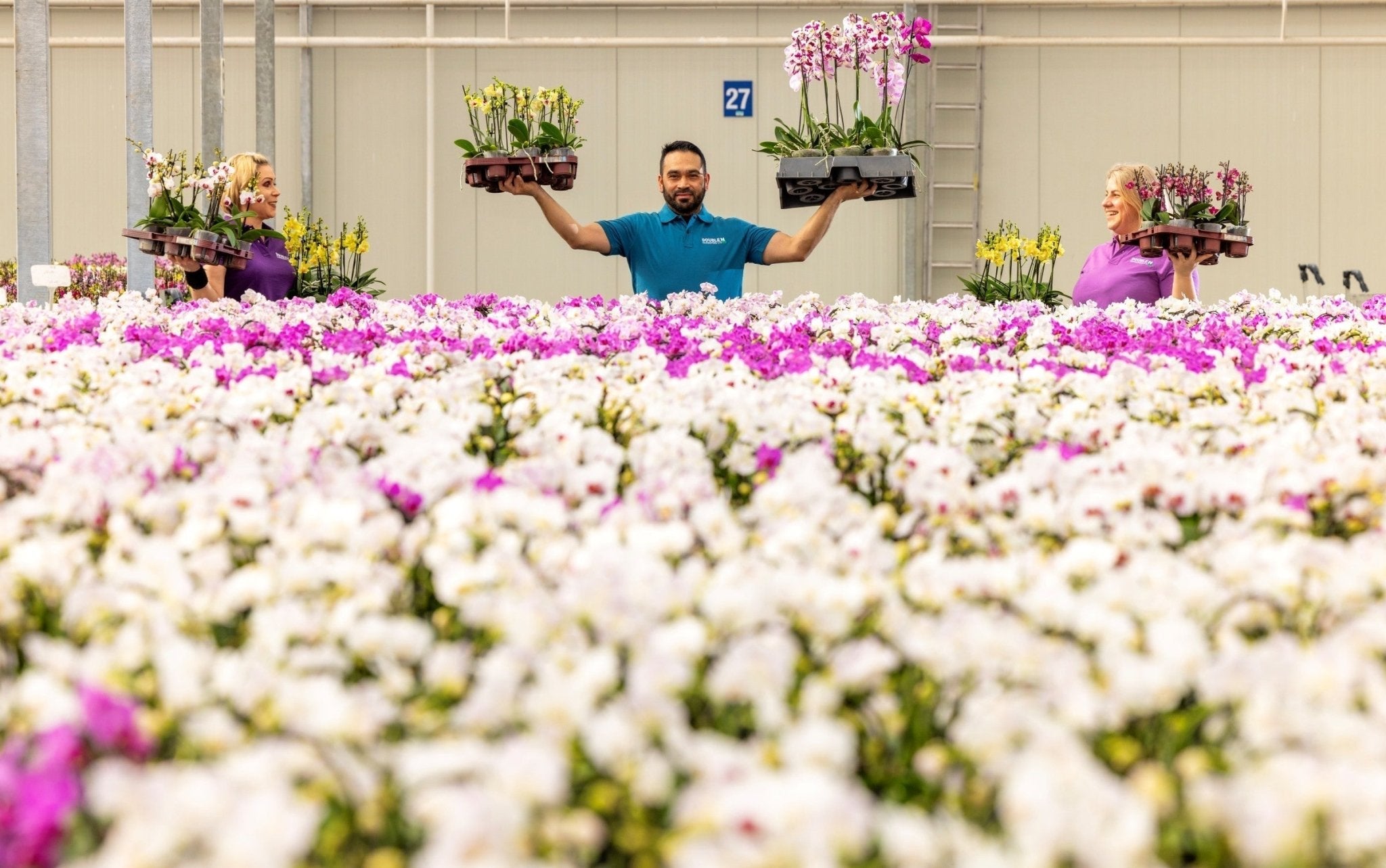How Long do Orchids Last?

Orchid care is different than most other types of plant care. Orchid growers need to know how to take care of their plants so to be able to get the most out of them.
Everyone who loves flowers agrees: Orchids are really beautiful plants. At one point, orchids were only available to the rich, but nowadays they're just as easily accessible as common houseplant flowers and potted green plants.
Whether you're a new orchid owner or have an extensive collection, caring for these beautiful plants doesn't have to be complicated. It all comes down to ensuring that your orchid receives enough water, the correct temperature, and an optimal growing medium. Below we have cultivated some great tips and information on how to get the most from your orchid!
How Long Do Orchids Live?
The lifespan of an orchid will depend on many factors, including the type of orchid, their environment, the proper care provided and watering. If properly cared for, they can bloom twice a year for 15-20 years, and in the case of phalaenopsis orchids, their blooms typically last from two to three months.
After the initial bloom has passed, the plants go into a resting phase. Some people think they've lost their orchids when they see them start to wilt and look like they're about to die. What isn't obvious though, is that the plant is actually saving up energy to prepare for its upcoming flowering season.

Keeping Your Orchids Happy and Healthy
Knowing the signs:
Here are a few common mistakes that novice orchid growers make. They're super easy to overlook, so don't feel ashamed if you're making any. It's all part of the learning process, trust me!
Overwatering: Leaves will look limp, sometimes leathery depending on its species. The existing leaves may begin to turn yellow.
Underwatering: Growth becomes stunted and flowers and leaves will start to wilt. Flower heads may also start to drop off.
Too much/little sunlight: Too much sunlight can damage plants' chlorophyll, turning them anemic green and causing them to lose their leaves prematurely. Dark green leaves indicate that a plant is getting insufficient light.
Wrong temperature: Cold damage appears on orchids as whitening of the foliage and stems, heat damage can show with yellow, withering leaves
Using the wrong potting medium: The orchid is struggling the drain through or is not retaining any water at all. This can then lead to over or under watering your orchid.
Orchid Care After Flowering
The after bloom care dictates the future success or failure of your orchid plant. After the flowers have wilted, you can either cut them back the stems or allow them to drop naturally. If you do decide to trim it, we suggest cutting the spike about an inch or so above the first node. At this stage, your orchid is going into its resting phase to store up the energy to re-bloom again.
If required, this would be the best time to repot your orchid. Potting into a large clear grow pot with drainage holes, using either sphagnum moss or bark chips (or a mixture!) as you medium. Orchid roots like to photosynthesize so using a clear grow pot helps the plant a lot. However, if you prefer you can always cover up the clear grow pot with a ceramic pot if this fits your aesthetic. Avoid forcefully pushing all of the roots down into the into the potting medium, roots that grow up and outwards of the grow pot are perfectly normal and called "aerial roots". Pushing or moving these aerial roots could result in damage or breakage which can end up killing your plant. When plants go through their resting phase, they put energy into new foliage (leaves) and root systems. Now you can fertilise your plants using a liquid orchid fertiliser; following the manufacturer's instructions, about once every month.


Placement In Your Home
It's important to choose the right location for your orchids. There are a few things that you need to consider when choosing the ideal spot.
You ideally want to pick somewhere that has a consistent room temperature. If there are any random spikes in temperature, they could cause your orchids' leaves to drop off. This is caused by the plant entering shock because of the sudden changes in its environment.
Another thing to bear in mind is the lighting. Orchids absolutely need bright, filtered sunlight. So it's best if you place it in a east/west facing window so it's not getting direct beams of sunlight. If that isn't an option, then just keep it out of direct sunlight, in a light room a few feet from the window. Failing that, you can always place something over the window to help filter out the direct sunlight.
Humidity is the last thing to think about when growing plants indoors. This is a tropical plant so it really enjoys a humid environment. Think of somewhere in your house where you can get humidity and light. The bathroom! Orchids tend to do pretty well near bathrooms, so it's an ideal spot to place one. Otherwise, you can give the kitchen a go or look to increase the humidity surrounding the plant manually.

What temperature is ideal for orchids?
Like most living things, orchids thrive with a bit of sun and a comfortable stable temperature. Being tropical plants, they mostly prefer temperatures ranging 25-35 degrees Celsius in bright indirect sunlight. Too much direct sunlight can cause the leaves to burn off the plant. You can increase the humidity level of your orchids by growing them with other plants, keeping them in a terrarium, or having a small humidifier near them. Most homes will have humidity levels of around 40% and this is usually just sufficient for most common orchid varieties however the optimal level for an orchid is around 60%.
What About Soil?
Orchids don't grow in regular indoor plant soil, so your best option is to plant them in bark chips or moss, or a mixture of the two, this gives the roots the ability to breathe.
The most common issue with household orchid plants it adding too much water, so a custom potting mix that includes moss, bark chips and maybe a bit of gravel, this provides a nice medium that allows for sufficient drainage. It is also important to note that the pot should have a drainage holes in the bottom so that any excess water never accumulates around the roots causing root rot.
After a year or so, moss and bark can start to break down and decompose, and that is a sure sign that is time to repot your orchids. leaving your orchids in decomposing medium for too long can cause root rot and bacterial infections that could kill your plant.

Selecting a Great Flowering Orchid
Orchids come in over 25,000 different varieties. The Phalaenopsis Orchid is popular and widely accessible because of its ability to bloom for a long time and its minimal maintenance requirements.
Colorful flower blooms help to sell orchids so most of them available to purchase will already be in bloom. This can be helpful as it lets you see and select a specific colour choice. On the other hand, the more blooms that are open on the plant at the time of purchase, the shorter the bloom time will last. If purchasing you orchid in person, time a pick the one with the most unopen buds, as you don't know how long the open flowers have been open for, and don't want to cheat yourself out of a long beautiful bloom period.
When purchasing in store - look at the stems and leaf surfaces for signs of insects and fungi. Orchids can be attractive to some types of insects. Check for white spots on the underside of leaves as an indication of pest infestation. Fungus looks like brown or black spots, usually with yellow around the edges. The key to preventing any issues down the line is to pick the best plant possible from the start and unless you are very familiar with rehabilitating orchids, avoid purchasing any "rescue" plants.

Promoting Orchid Reblooming
Getting your moth orchid to rebloom is not difficult if you follow these super easy to remember steps;
- If you stem is green - remove all clips and stakes, and trim the stem about an inch above the first node (below the lowest flower bloom)
- if your stem is turning brown - trim the stem at the base of the plant (most orchids will not reflower on brown stems)
- If you have a 2 stem orchid do one of each of the above cuttings.
- Continue to water your plant as usual - they still require the same sustenance even when "resting"
- Feed your orchids once or twice a month by watering them with a diluted houseplant fertilizer at half its recommended concentration.
- Ensure your orchid has plenty of indirect sunlight
- Let your orchid cool at night - this helps to promote new flower spikes
- When your orchids are getting ready to bloom again, you’ll notice what may look like roots growing out of their media. The tip of this growth should take the shape of a mitten. As it grows, you may need to insert a stake to support the stem - make sure this has finished growing before clipping it to the stake
Following these simple steps should get your Phalaenopsis orchid to rebloom about twice a year, holding those beautiful orchid blooms for months at a time. Once you have achieved this. it'll start to get easier and easier with every rebloom.




